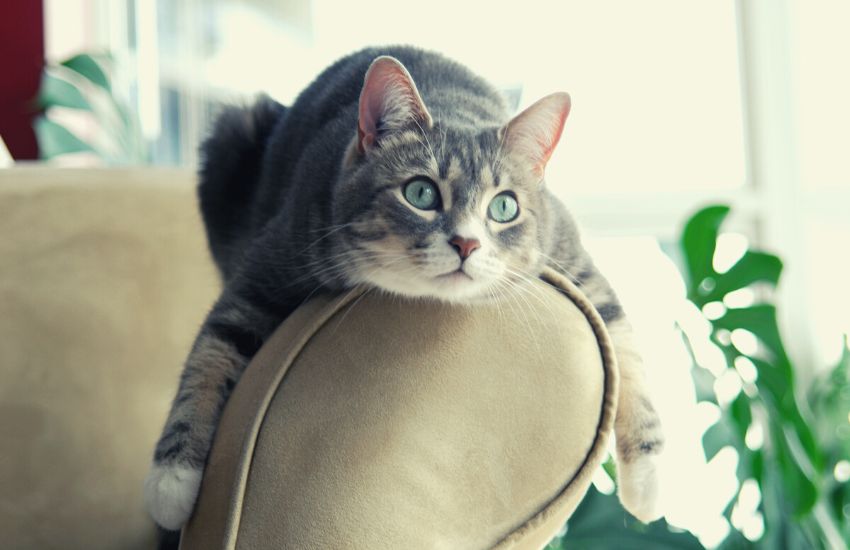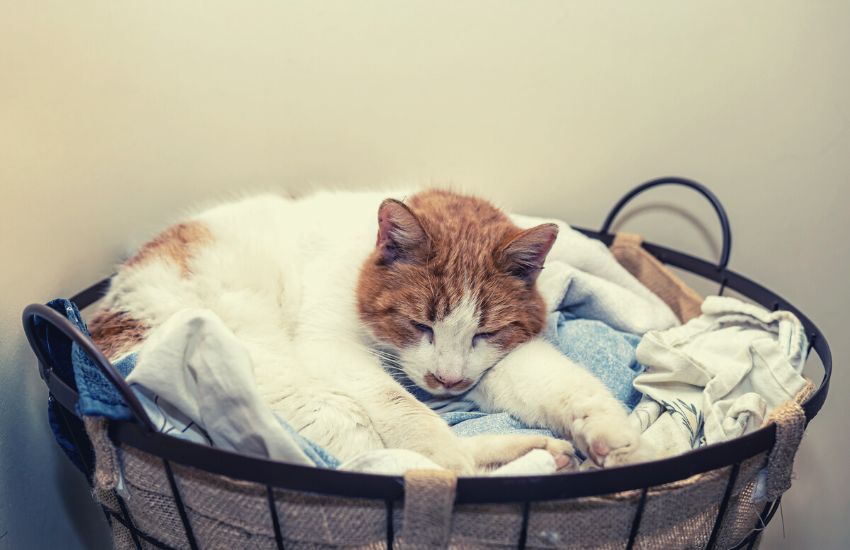shelter pets in need
Each order helps pets in need

Are you considering adding a new kitten or adult cat to your family? Excellent choice! If you currently don't have any pets, it's essential to take a few minutes to ensure your house is safe for your new cat. Adopting a cat isn't all rainbows and cute merch. Seemingly simple things can be hazardous to a curious cat, so take a quick look around to ensure your home is cat-friendly.
Before bringing a feline friend into your home, it's essential to make sure your space is ready to welcome them. Cats are naturally curious creatures and will want to explore every nook and cranny in their new domain.
Cats feel most comfortable when they have spaces to call their own. Giving them places to scratch, climb, hide, and rest in each room will make them feel at home in no time. Preparing in advance and cat-proofing potential hazards in your living space will ensure a smooth transition for your cat into its new home.
One of the biggest dangers for curious kitties is exposed electrical cords and cables. To protect your furry friend, you'll want to block access to anything they might bat around or chew on.
First, bundle up and tie any loose cords behind furniture or appliances. Securing cables together makes them less tempting to swat at or nibble on. You can also slide them inside cord covers or organizers to conceal them completely.
For plugged cords, try placing double-sided tape, aluminum foil, or motion-activated air sprayers near the outlet to startle your cat away from the area. Bitter apple spray or citrus scents can also deter cats when applied directly to cords.
In a pinch, you can conceal dangling cords inside PVC or slit tubing or wrap them in duct tape for an unappealing texture. Place protective corner and edge bumpers over cord entry points into walls to avoid damage from teeth or claws.

If you've already heard of high-rise syndrome in cats, you know how important it is to ensure all the screens in your windows are safe and secure. Windows and patio doors without screens should not be left open to ensure your cat won't get out.
Sewing, knitting, and crafting supplies can be incredibly enticing but hazardous for curious cats. Make sure things like needles, yarn, and thread are in securely covered containers. Do a quick survey of fragile knick-knacks and remove any that you don't want to be broken by a jumping cat. Monitor your cat around open fireplaces.
Scratching posts give cats a place to scratch that isn't your furniture. Look for tall, sturdy posts made of good material, like sisal rope, that cats love scratching. Place posts near areas where your cat usually scratches the furniture, like near the couch or bed. You may need to train your cat to use the posts at first with treats, praise, and play.
Scratching pads, like cardboard scratchers, also provide an enticing scratching surface. They have the added benefit of being inexpensive and portable, so you can move them around and replace them as needed. Look for pads with catnip or treats to make them even more appealing.
Provide multiple scratching posts and pads throughout your home, especially in central living areas. The more options you give your cat, the less likely they will scratch the furniture.
Consider soft plastic covers for the corners and arms of couches and chairs.
Trim your pet's nails regularly to minimize damage from scratching.
Offer lots of playtime and affection to prevent scratching behavior caused by boredom or stress.
Giving your cat appropriate outlets for normal scratching behavior is critical to saving your furniture and creating a harmonious home for all. Providing posts, pads, and training are some of the most effective ways to redirect your cat's scratching positively. With time and consistency, you'll have a purr-fectly clawed-free space.

As a cat owner, it's essential to be aware of plants that could be poisonous to your feline friend. Many common houseplants and flowers contain toxic substances that can make cats sick if they chew on them.
Keep plants like lilies, tulips, azaleas, dieffenbachia, and philodendrons out of reach, or avoid having them in your home altogether. These plants' leaves, stems, and flowers are all toxic to cats and can cause nausea, vomiting, and even organ failure if eaten. It's best not to take any chances.
Place all houseplants on high shelves your cat can't access. Opt for hanging or wall planters that keep greenery up and away if possible. You should also avoid leaving cut flowers in low vases where curious kitties can enter them.
If you have toxic plants in your home, watch your cat closely to ensure they don't chew on them. Be aware of any signs of poisoning like drooling, dilated pupils, difficulty breathing, or collapse and take your cat to a veterinarian immediately. It's always better to be safe than sorry in this case.
To keep your curious cat safe, securely store any household cleaners, chemicals, or medications. These substances can be highly toxic to felines if ingested, even in small amounts.
Keep all cleaning supplies, laundry detergents, bleaches, and other hazardous chemicals in locked cabinets your cat cannot access. Don't leave them sitting out after using them.
Make sure all human and veterinary medications are kept in sealed containers and locked away. Some over-the-counter and prescription drugs can be deadly to cats.
Use child-proof safety locks on cabinets and drawers to prevent your cat from helping themselves when you're not looking. Double-check that everything is securely fastened and locked.
Never leave cleaning cloths, paper towels, or rags dampened with chemicals around where a cat might chew on them.
Secure the bag tightly when taking out the trash to prevent your cat from investigating anything potentially dangerous inside.
By properly securing and containing these harmful substances in your home, you can rest easy knowing your curious cat's health and safety are protected. Make it a habit to double-check that cabinets and drawers are locked up tight every time to avoid accidental poisoning or exposure.
One of the most important things you can do to keep your cat happy in their space is to scoop their litter box daily. Cats are clean creatures and prefer a tidy area to do their business. Scooping solid waste daily will prevent odors from building up and ensure your cat continues using their box.
Providing your cat with a litter area will make them much more comfortable in your home. Be sure to also supply litter boxes on every floor of your house, especially for senior or disabled cats. Keeping the litter area clean and catering to your cat's needs will give you a happy, well-adjusted feline companion in your space.
Some cat owners prefer to use litter box liners to make cleaning easier. Liners can help prevent litter from sticking to the bottom of the box but must be changed frequently to avoid odor buildup. Only use non-scented, unbleached liners designed explicitly for litter boxes. Never use plastic bags, as these can be a choking or suffocation hazard for curious cats. Always ensure liners do not hang over the edge of the box where your cat could chew or scratch them.
Cats are curious creatures and love climbing and jumping on furniture. Ensure any top-heavy pieces in your home are secured so they can't be tipped over easily. This includes:
Dressers: Secure dressers to the wall behind them. A cat leaping on top could cause them to topple forward if they aren't anchored. Use safety brackets, straps, or wall anchors designed for furniture.
Bookcases: Tall bookcases should also be secured to walls. It only takes a cat brushing against or pouncing on a bookcase to send it crashing down. Use the same methods to anchor bookcases as you would for dressers.
Shelving units: Freestanding shelving units pose the same risks as bookcases if not correctly secured. Ensure shelving is not overloaded to reduce the chance of collapse even if anchored.
Entertainment centers: Large TVs, stereos, and other electronics in an entertainment center make it prone to tipping. Secure the center to studs in the walls behind it to prevent it from falling forward if a cat jumps on top.
Table lamps: Consider securing tall table lamps to end tables or other surfaces. Cats may bat at dangling cords or use the lights as launching pads, causing them to topple over. Use strong double-sided tape, museum putty, or other non-damaging adhesives to stick it in place on the lamp base.
Anchoring unstable and top-heavy furniture helps ensure your cat stays safe while preventing damage to your home and belongings. Make it a habit to evaluate any new piece of furniture for its potential to tip over before placing it in your cat's path.

Make sure you leave the doors to washers and dryers closed so that the cat won't get into them. It's also a good idea to put away cleaning supplies and laundry detergent and keep the lids of trash cans down. Garbage in lidless wastebaskets is tempting to a curious cat. Never leave a hot iron unattended on an ironing board with the cat around.
There are many kitchen hazards for cats, especially since they can quickly jump on the counters. Keep an eye on your cat around hot stoves and ovens, pots of boiling liquids, sharp knives, and electric plug-ins like coffee pots and kettles. It's also a good idea to put away grocery bags with handles, as cats like to go in bags but can easily get their necks and legs caught in the handles.
Short answer: yes! Cats are curious creatures and can get into all sorts of mischief if you don't take some basic precautions. Cat-proofing your home will help keep your feline friend safe and your belongings intact.
You'll want to ensure any outdoor areas are contained and escape-proof. Install a sturdy fence at least 5 to 6 feet high, with no gaps wider than 2 inches. Bury the bottom of the fence a few inches into the ground or place heavy stones along the base. This prevents your cat from sneaking underneath.
Cats are excellent climbers, so you must make vertical surfaces inaccessible. Apply double-sided tape, aluminum foil, or motion-activated devices to fences, trees, and outdoor furniture. These make the area unpleasant without harming your cat.
Leave a comment